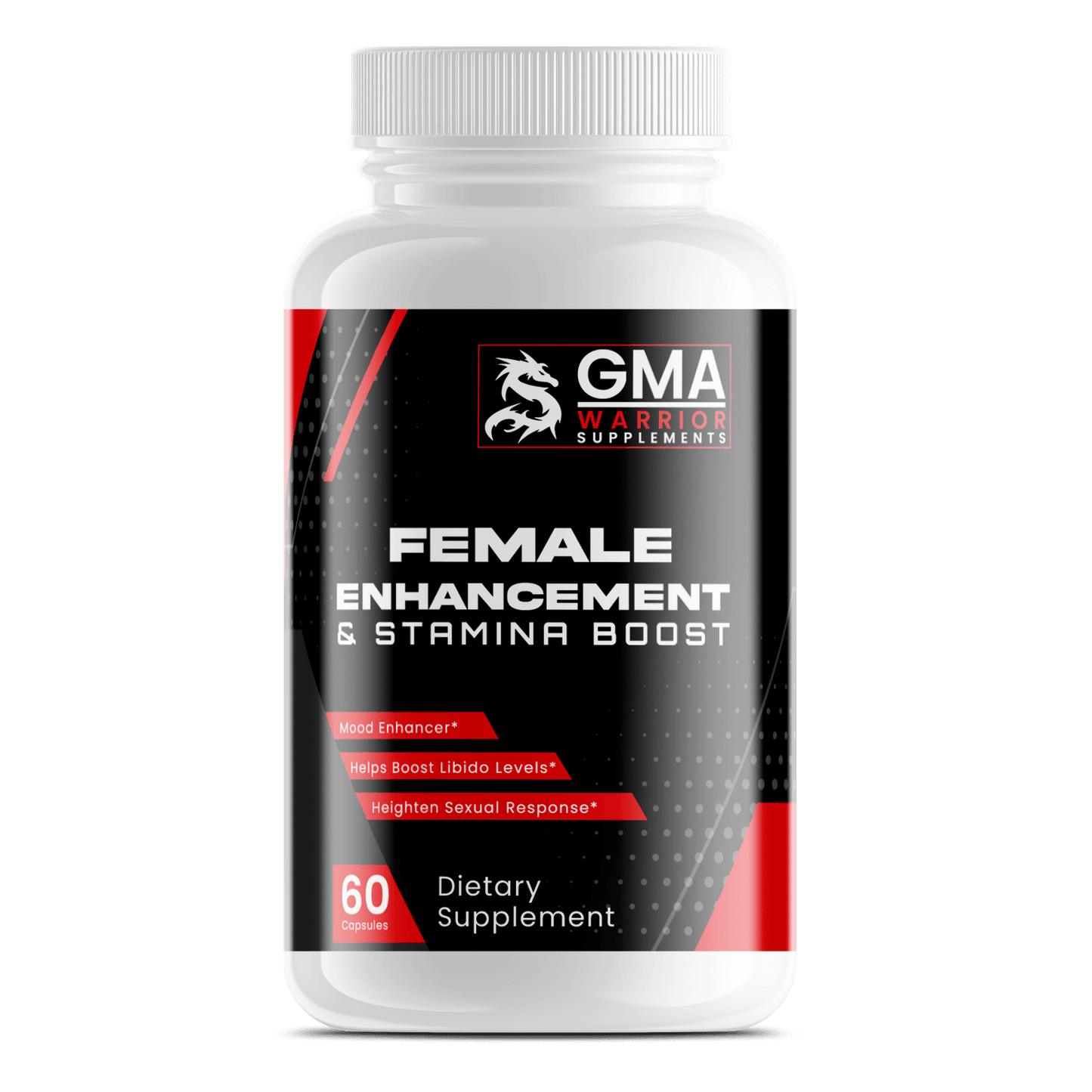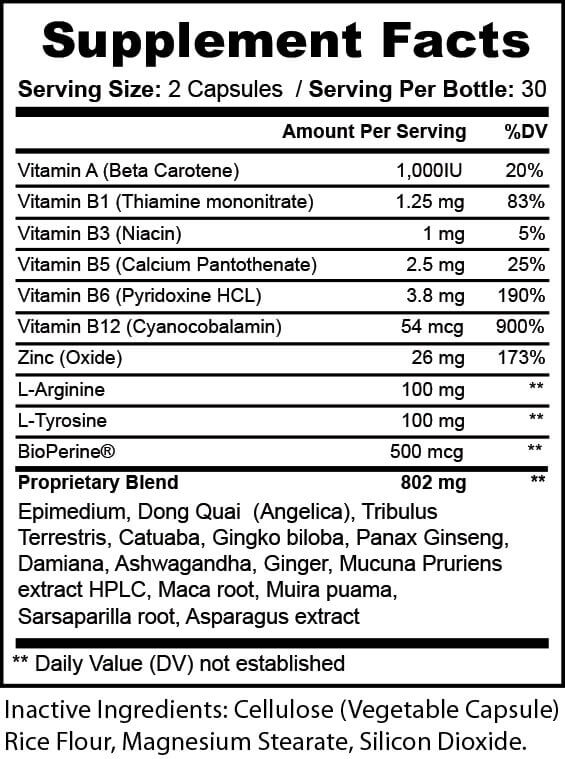Women’s Health, Hair, Skin & Beauty
GMA Female Enhancement & Stamina Boost
GMA Female Enhancement & Stamina Boost
Impossibile caricare la disponibilità di ritiro
Description
GMA Warrior Female Stamina Boost is a blend of natural herbs and vitamins that are specifically formulated to naturally help enhance female libido levels, stamina, sexual stimulation, and enjoyment. By helping the body increase natural lubrication, for a more heightened sexual response.*
| Formula Purposes & Benefits |
|
GMA Warrior Female Enhancement & Stamina Boost is formulated to increase sexual arousal, sexual function, positive mood, reduced cortisol, increased nitric oxide production, increased muscle mass, and improved exercise performance. Our product is synthesized utilizing the latest scientific research and formulated with high-quality ingredients. Our formula is third-party independently tested for heavy metals, impurities, made in the USA, GMP certified, and produced in an FDA registered facility. 1% of the supplements on the market can match our world-class standards. |
| Formula Ingredient Deck | Benefits Of Each Ingredient |
| Vitamin A (beta carotene) |
|
| Vitamin B1 (Thiamine) |
|
| Vitamin B2 (Riboflavin) |
|
| Vitamin B3 (Niacin) |
|
| Vitamin B6 |
|
| Vitamin B12 |
|
| Zinc |
|
| L-Tyrosine |
|
| Maca Root Powder |
|
| Munica Pruriens |
|
| Muira Puama Root Powder |
|
| L-Arginine |
|
| Panax Ginseng |
|
| Epimedium/Horny Goat Weed |
|
| Dong Quai |
|
| Tribulus Terrestris |
|
| Damiana |
|
| Ashwagandha |
|
| Ginger |
|
| Sarsaparilla root |
|
| Asparagus |
|
| Proper Use of This Supplement |
| Suggested Use: As a dietary supplement take two (2) veggie capsules once a day. For best results, light exercise and a sensible diet are recommended. Use this product for no less than 8 weeks for maximum results. Do not exceed 4 capsules a day. |
| Our Formula Vs Other Formulas on the Market. | |
| 1. Uses third-party independently tested ingredients that are made in the USA, GMP certified, and made in an FDA registered facility. | 1. Source cheap ingredients from heavily polluted soils. Even “organic” supplements not third-party tested have been removed by FDA due to high levels of heavy metals. |
| 2. High-quality turmeric and ginger in an effective and efficaciously dosed formula | 2. Uses cheap sources of turmeric and ginger that contain high amounts of fillers and heavy metals. |
Sources
1.Sureda, A., & Pons, A. (2012). Arginine and citrulline supplementation in sports and exercise: ergogenic nutrients?. Medicine and sport science, 59, 18–28. https://doi.org/10.1159/000341937
2.Szefel, J., Danielak, A., & Kruszewski, W. J. (2019). Metabolic pathways of L-arginine and therapeutic consequences in tumors. Advances in medical sciences, 64(1), 104–110. https://doi.org/10.1016/j.advms.2018.08.018
3.Rodrigues-Krause, J., Krause, M., Rocha, I., Umpierre, D., & Fayh, A. (2018). Association of l-Arginine Supplementation with Markers of Endothelial Function in Patients with Cardiovascular or Metabolic Disorders: A Systematic Review and Meta-Analysis. Nutrients, 11(1), 15. https://doi.org/10.3390/nu11010015
4.Hu, S., Han, M., Rezaei, A., Li, D., Wu, G., & Ma, X. (2017). L-Arginine Modulates Glucose and Lipid Metabolism in Obesity and Diabetes. Current protein & peptide science, 18(6), 599–608. https://doi.org/10.2174/1389203717666160627074017
9.Gasperi, V., Sibilano, M., Savini, I., & Catani, M. V. (2019). Niacin in the Central Nervous System: An Update of Biological Aspects and Clinical Applications. International journal of molecular sciences, 20(4), 974. https://doi.org/10.3390/ijms20040974
10.Gentilcore D. (2016). Louis Sambon and the Clash of Pellagra Etiologies in Italy and the United States, 1905-14. Journal of the history of medicine and allied sciences, 71(1), 19–42. https://doi.org/10.1093/jhmas/jrv002
11.Kirkland J. B. (2009). Niacin status and treatment-related leukemogenesis. Molecular cancer therapeutics, 8(4), 725–732. https://doi.org/10.1158/1535-7163.MCT-09-0042
12.Hoskin, P., Rojas, A., & Saunders, M. (2009). Accelerated radiotherapy, carbogen, and nicotinamide (ARCON) in the treatment of advanced bladder cancer: mature results of a Phase II nonrandomized study. International journal of radiation oncology, biology, physics, 73(5), 1425–1431. https://doi.org/10.1016/j.ijrobp.2008.06.1950
- Ueland, P. M., McCann, A., Midttun, Ø., & Ulvik, A. (2017). Inflammation, vitamin B6 and related pathways. Molecular aspects of medicine, 53, 10–27. https://doi.org/10.1016/j.mam.2016.08.001
- Bird R. P. (2018). The Emerging Role of Vitamin B6 in Inflammation and Carcinogenesis. Advances in food and nutrition research, 83, 151–194. https://doi.org/10.1016/bs.afnr.2017.11.004
- Mascolo, E., & Vernì, F. (2020). Vitamin B6 and Diabetes: Relationship and Molecular Mechanisms. International journal of molecular sciences, 21(10), 3669. https://doi.org/10.3390/ijms21103669
- van de Lagemaat, E. E., de Groot, L., & van den Heuvel, E. (2019). Vitamin B12in Relation to Oxidative Stress: A Systematic Review. Nutrients, 11(2), 482. https://doi.org/10.3390/nu11020482
- Romain, M., Sviri, S., Linton, D. M., Stav, I., & van Heerden, P. V. (2016). The role of Vitamin B12 in the critically ill--a review. Anaesthesia and intensive care, 44(4), 447–452. https://doi.org/10.1177/0310057X1604400410
- Shipton, M. J., & Thachil, J. (2015). Vitamin B12 deficiency - A 21st century perspective . Clinical medicine (London, England), 15(2), 145–150. https://doi.org/10.7861/clinmedicine.15-2-145
- Hoffer, L. J., Sher, K., Saboohi, F., Bernier, P., MacNamara, E. M., & Rinzler, D. (2003). N-acetyl-L-tyrosine as a tyrosine source in adult parenteral nutrition. JPEN. Journal of parenteral and enteral nutrition, 27(6), 419–422. https://doi.org/10.1177/0148607103027006419
- Ipson, B. R., & Fisher, A. L. (2016). Roles of the tyrosine isomers meta-tyrosine and ortho-tyrosine in oxidative stress. Ageing research reviews, 27, 93–107. https://doi.org/10.1016/j.arr.2016.03.005
- Langade, D., Kanchi, S., Salve, J., Debnath, K., & Ambegaokar, D. (2019). Efficacy and Safety of Ashwagandha (Withania somnifera) Root Extract in Insomnia and Anxiety: A Double-blind, Randomized, Placebo-controlled Study. Cureus, 11(9), e5797. https://doi.org/10.7759/cureus.5797
- Bonilla, D. A., Moreno, Y., Gho, C., Petro, J. L., Odriozola-Martínez, A., & Kreider, R. B. (2021). Effects of Ashwagandha (Withania somnifera) on Physical Performance: Systematic Review and Bayesian Meta-Analysis. Journal of functional morphology and kinesiology, 6(1), 20. https://doi.org/10.3390/jfmk6010020
- Thakur, K., Tomar, S. K., Singh, A. K., Mandal, S., & Arora, S. (2017). Riboflavin and health: A review of recent human research. Critical reviews in food science and nutrition, 57(17), 3650–3660. https://doi.org/10.1080/10408398.2016.1145104
- Suwannasom, N., Kao, I., Pruß, A., Georgieva, R., & Bäumler, H. (2020). Riboflavin: The Health Benefits of a Forgotten Natural Vitamin. International journal of molecular sciences, 21(3), 950. https://doi.org/10.3390/ijms21030950
- DiNicolantonio, J. J., Niazi, A. K., Lavie, C. J., O'Keefe, J. H., & Ventura, H. O. (2013). Thiamine supplementation for the treatment of heart failure: a review of the literature. Congestive heart failure (Greenwich, Conn.), 19(4), 214–222. https://doi.org/10.1111/chf.12037
- Saedisomeolia, A., & Ashoori, M. (2018).Thiamine in Human Health: A Review of Current Evidences. Advances in food and nutrition research, 83, 57–81. https://doi.org/10.1016/bs.afnr.2017.11.002
- Hasani, H., Arab, A., Hadi, A., Pourmasoumi, M., Ghavami, A., & Miraghajani, M. (2019). Does ginger supplementation lower blood pressure? A systematic review and meta-analysis of clinical trials. Phytotherapy research : PTR, 33(6), 1639–1647. https://doi.org/10.1002/ptr.6362
- Kuchakulla, M., Narasimman, M., Soni, Y., Leong, J. Y., Patel, P., & Ramasamy, R. (2021). A systematic review and evidence-based analysis of ingredients in popular male testosterone and erectile dysfunction supplements. International journal of impotence research, 33(3), 311–317. https://doi.org/10.1038/s41443-020-0285-x
- Fang, J., & Zhang, Y. (2017). Icariin, an Anti-atherosclerotic Drug from Chinese Medicinal Herb Horny Goat Weed. Frontiers in pharmacology, 8, 734. https://doi.org/10.3389/fphar.2017.00734
13.Dording, C. M., Schettler, P. J., Dalton, E. D., Parkin, S. R., Walker, R. S., Fehling, K. B., Fava, M., & Mischoulon, D. (2015). A double-blind placebo-controlled trial of maca root as treatment for antidepressant-induced sexual dysfunction in women. Evidence-based complementary and alternative medicine : eCAM, 2015, 949036. https://doi.org/10.1155/2015/949036
- Pathania, R., Chawla, P., Khan, H., Kaushik, R., & Khan, M. A. (2020). An assessment of potential nutritive and medicinal properties of Mucuna pruriens: a natural food legume. 3 Biotech, 10(6), 261. https://doi.org/10.1007/s13205-020-02253-x
- Rakesh B, Praveen N (2020) Chapter-10 biotechnological approaches for the production of l-DOPA: a novel and potent anti-Parkinson’s Drug from Mucuna pruriens (L.) DC. Chief Editor: 179
- Majekodunmi, S. O., Oyagbemi, A. A., Umukoro, S., & Odeku, O. A. (2011). Evaluation of the anti-diabetic properties of Mucuna pruriens seed extract. Asian Pacific journal of tropical medicine, 4(8), 632–636. https://doi.org/10.1016/S1995-7645(11)60161-2
- Ferrini, M. G., Garcia, E., Abraham, A., Artaza, J. N., Nguyen, S., & Rajfer, J. (2018). Effect of ginger, Paullinia cupana, muira puama and l- citrulline, singly or in combination, on modulation of the inducible nitric oxide- NO-cGMP pathway in rat penile smooth muscle cells. Nitric oxide : biology and chemistry, 76, 81–86. https://doi.org/10.1016/j.niox.2018.03.010
- Sellami, M., Slimeni, O., Pokrywka, A., Kuvačić, G., D Hayes, L., Milic, M., & Padulo, J. (2018). Herbal medicine for sports: a review. Journal of the International Society of Sports Nutrition, 15, 14. https://doi.org/10.1186/s12970-018-0218-y
- Sellami, M., Slimeni, O., Pokrywka, A., Kuvačić, G., D Hayes, L., Milic, M., & Padulo, J. (2018). Herbal medicine for sports: a review. Journal of the International Society of Sports Nutrition, 15, 14. https://doi.org/10.1186/s12970-018-0218-y
- Saudan, C., Baume, N., Emery, C., Strahm, E., & Saugy, M. (2008). Short term impact of Tribulus terrestris intake on doping control analysis of endogenous steroids. Forensic science international, 178(1), e7–e10. https://doi.org/10.1016/j.forsciint.2008.01.003
- Palacios, S., Soler, E., Ramírez, M., Lilue, M., Khorsandi, D., & Losa, F. (2019). Effect of a multi-ingredient based food supplement on sexual function in women with low sexual desire. BMC women's health, 19(1), 58. https://doi.org/10.1186/s12905-019-0755-9
- Das, S., & Bisht, S. S. (2013). The bioactive and therapeutic potential of Hemidesmus indicus R. Br. (Indian Sarsaparilla) root. Phytotherapy research : PTR, 27(6), 791–801. https://doi.org/10.1002/ptr.4788
- She, T., Qu, L., Wang, L., Yang, X., Xu, S., Feng, J., Gao, Y., Zhao, C., Han, Y., Cai, S., & Shou, C. (2015). Sarsaparilla (Smilax Glabra Rhizome) Extract Inhibits Cancer Cell Growth by S Phase Arrest, Apoptosis, and Autophagy via Redox-Dependent ERK1/2 Pathway. Cancer prevention research (Philadelphia, Pa.), 8(5), 464–474. https://doi.org/10.1158/1940-6207.CAPR-14-0372
- Majumdar, S., Gupta, S., Prajapati, S. K., & Krishnamurthy, S. (2021). Neuro-nutraceutical potential of Asparagus racemosus: A review. Neurochemistry international, 145, 105013. https://doi.org/10.1016/j.neuint.2021.105013
- Maywald, M., Wessels, I., & Rink, L. (2017). Zinc Signals and Immunity. International journal of molecular sciences, 18(10), 2222. https://doi.org/10.3390/ijms18102222
- Wessels, I., Rolles, B., & Rink, L. (2020). The Potential Impact of Zinc Supplementation on COVID-19 Pathogenesis. Frontiers in immunology, 11, 1712. https://doi.org/10.3389/fimmu.2020.01712
Serving Size: 2 Capsules;
Capsules Per Container: 60;
Bottle Color: White;
Bottle Size: 175cc;
Lid Color: White

* These statements have not been evaluated by the Food and Drug Administration. This product is not intended to diagnose, treat, cure or prevent any disease.




